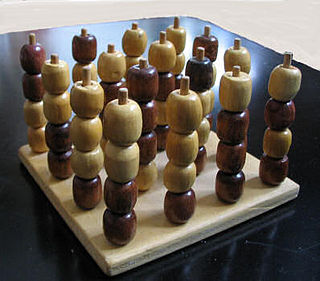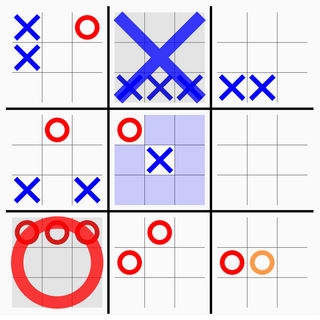
A mathematical game is a game whose rules, strategies, and outcomes are defined by clear mathematical parameters. Often, such games have simple rules and match procedures, such as tic-tac-toe and dots and boxes. Generally, mathematical games need not be conceptually intricate to involve deeper computational underpinnings. For example, even though the rules of Mancala are relatively basic, the game can be rigorously analyzed through the lens of combinatorial game theory.

Tic-tac-toe, noughts and crosses, or Xs and Os is a paper-and-pencil game for two players who take turns marking the spaces in a three-by-three grid with X or O. The player who succeeds in placing three of their marks in a horizontal, vertical, or diagonal row is the winner. It is a solved game, with a forced draw assuming best play from both players.

Combinatorial game theory is a branch of mathematics and theoretical computer science that typically studies sequential games with perfect information. Study has been largely confined to two-player games that have a position that the players take turns changing in defined ways or moves to achieve a defined winning condition. Combinatorial game theory has not traditionally studied games of chance or those that use imperfect or incomplete information, favoring games that offer perfect information in which the state of the game and the set of available moves is always known by both players. However, as mathematical techniques advance, the types of game that can be mathematically analyzed expands, thus the boundaries of the field are ever changing. Scholars will generally define what they mean by a "game" at the beginning of a paper, and these definitions often vary as they are specific to the game being analyzed and are not meant to represent the entire scope of the field.
Combinatorial game theory measures game complexity in several ways:
- State-space complexity,
- Game tree size,
- Decision complexity,
- Game-tree complexity,
- Computational complexity.

An m,n,k-game is an abstract board game in which two players take turns in placing a stone of their color on an m-by-n board, the winner being the player who first gets k stones of their own color in a row, horizontally, vertically, or diagonally. Thus, tic-tac-toe is the 3,3,3-game and free-style gomoku is the 15,15,5-game. An m,n,k-game is also called a k-in-a-row game on an m-by-n board.

3D tic-tac-toe, also known by the trade name Qubic, is an abstract strategy board game, generally for two players. It is similar in concept to traditional tic-tac-toe but is played in a cubical array of cells, usually 4×4×4. Players take turns placing their markers in blank cells in the array. The first player to achieve four of their own markers in a row wins. The winning row can be horizontal, vertical, or diagonal on a single board as in regular tic-tac-toe, or vertically in a column, or a diagonal line through four boards.
In mathematics, the Hales–Jewett theorem is a fundamental combinatorial result of Ramsey theory named after Alfred W. Hales and Robert I. Jewett, concerning the degree to which high-dimensional objects must necessarily exhibit some combinatorial structure; it is impossible for such objects to be "completely random".
In combinatorial game theory, the strategy-stealing argument is a general argument that shows, for many two-player games, that the second player cannot have a guaranteed winning strategy. The strategy-stealing argument applies to any symmetric game in which an extra move can never be a disadvantage. A key property of a strategy-stealing argument is that it proves that the first player can win the game without actually constructing such a strategy. So, although it might prove the existence of a winning strategy, the proof gives no information about what that strategy is.

Score Four is a "three dimensional" abstract strategy game, similar to Connect Four. It was first sold under the name "Score Four" by Funtastic in 1968. Lakeside issued 4 different versions in the 1970s. Later Hasbro sold the game as "Connect Four Advanced" in the UK.
Harary's generalized tic-tac-toe or animal tic-tac-toe is a generalization of the game tic-tac-toe, defining the game as a race to complete a particular polyomino on a square grid of varying size, rather than being limited to "in a row" constructions. It was devised by Frank Harary in March 1977, and is a broader definition than that of an m,n,k-game.

In combinatorial game theory, a two-player deterministic perfect information turn-based game is a first-player-win if with perfect play the first player to move can always force a win. Similarly, a game is second-player-win if with perfect play the second player to move can always force a win. With perfect play, if neither side can force a win, the game is a draw.
A positional game is a kind of a combinatorial game for two players. It is described by:
Kaplansky's game or Kaplansky's n-in-a-line is an abstract board game in which two players take turns in placing a stone of their color on an infinite lattice board, the winner being the player who first gets k stones of their own color on a line which does not have any stones of the opposite color on it. It is named after Irving Kaplansky.

Ultimate tic-tac-toe is a board game composed of nine tic-tac-toe boards arranged in a 3 × 3 grid. Players take turns playing on the smaller tic-tac-toe boards until one of them wins on the larger board. Compared to traditional tic-tac-toe, strategy in this game is conceptually more difficult and has proven more challenging for computers.

Tic-tac-toe is an instance of an m,n,k-game, where two players alternate taking turns on an m×n board until one of them gets k in a row. Harary's generalized tic-tac-toe is an even broader generalization. The game can also be generalized as a nd game. The game can be generalised even further from the above variants by playing on an arbitrary hypergraph where rows are hyperedges and cells are vertices.
Treblecross is a degenerate tic-tac toe variant. The game is an octal game, played on a one-dimensional board and both players play using the same piece. Each player on their turn plays a piece in an unoccupied space. The game is won if a player on their turn makes a line of three pieces in a row.
A strong positional game is a kind of positional game. Like most positional games, it is described by its set of positions and its family of winning-sets. It is played by two players, called First and Second, who alternately take previously-untaken positions.
Combinatorial Games: Tic-Tac-Toe Theory is a monograph on the mathematics of tic-tac-toe and other positional games, written by József Beck. It was published in 2008 by the Cambridge University Press as volume 114 of their Encyclopedia of Mathematics and its Applications book series (ISBN 978-0-521-46100-9).
In the mathematical study of combinatorics on words, a parameter word is a string over a given alphabet having some number of wildcard characters. The set of strings matching a given parameter word is called a parameter set or combinatorial cube. Parameter words can be composed, to produce smaller subcubes of a given combinatorial cube. They have applications in Ramsey theory and in computer science in the detection of duplicate code.
In mathematics, the Graham–Rothschild theorem is a theorem that applies Ramsey theory to combinatorics on words and combinatorial cubes. It is named after Ronald Graham and Bruce Lee Rothschild, who published its proof in 1971. Through the work of Graham, Rothschild, and Klaus Leeb in 1972, it became part of the foundations of structural Ramsey theory. A special case of the Graham–Rothschild theorem motivates the definition of Graham's number, a number that was popularized by Martin Gardner in Scientific American and listed in the Guinness Book of World Records as the largest number ever appearing in a mathematical proof.










